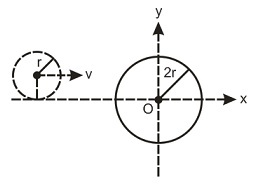Q.
A small smooth disc of mass $m$ and radius $r$ moving with an initial velocity $v$ along the positive $x$ -axis collided with a big disc of mass $2m$ and radius $2r$ which was initially at rest with its centre at origin as shown in the figure. If the coefficient of restitution is $0$ , then the velocity of the larger disc after the collision is

NTA AbhyasNTA Abhyas 2020
Solution:
